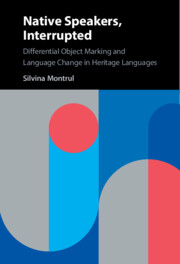Book contents
- Native Speakers, Interrupted
- Native Speakers, Interrupted
- Copyright page
- Dedication
- Contents
- Figures
- Tables
- Preface
- Abbreviations
- Introduction
- 1 On Heritage Speakers as Native Speakers
- 2 Structural Changes in Heritage Language Grammars
- 3 Differential Object Marking
- 4 Language Change and the Acquisition of Differential Object Marking
- 5 The Vulnerability of Differential Object Marking in Three Heritage Languages
- 6 Differential Object Marking in Spanish as a Heritage Language
- 7 Differential Object Marking in Hindi as a Heritage Language
- 8 Differential Object Marking and Clitic Doubling in Romanian as a Heritage Language
- 9 Comparing the Three Heritage Languages
- 10 Intergenerational Transmission
- Implications
- References
- Index
6 - Differential Object Marking in Spanish as a Heritage Language
Published online by Cambridge University Press: 15 December 2022
- Native Speakers, Interrupted
- Native Speakers, Interrupted
- Copyright page
- Dedication
- Contents
- Figures
- Tables
- Preface
- Abbreviations
- Introduction
- 1 On Heritage Speakers as Native Speakers
- 2 Structural Changes in Heritage Language Grammars
- 3 Differential Object Marking
- 4 Language Change and the Acquisition of Differential Object Marking
- 5 The Vulnerability of Differential Object Marking in Three Heritage Languages
- 6 Differential Object Marking in Spanish as a Heritage Language
- 7 Differential Object Marking in Hindi as a Heritage Language
- 8 Differential Object Marking and Clitic Doubling in Romanian as a Heritage Language
- 9 Comparing the Three Heritage Languages
- 10 Intergenerational Transmission
- Implications
- References
- Index
Summary
The acquisition of DOM in Spanish monolingual children and Spanish-speaking bilinguals has been intensely investigated in the last two decades. One of the main objectives of the in-depth study of DOM conducted for this project was to confirm and evaluate the strength of previous findings of DOM omission in Spanish-English bilingual children and in young adult heritage speakers. If erosion of DOM in Spanish as a heritage language is indeed a robust phenomenon, it should be documented in other groups of heritage speakers. Although hypotheses about the potential role of the parental generation in contributing to heritage language grammars abound, at the time the Spanish study reported in this book was conceived, there were no studies of potential attrition of DOM in adult immigrants. Therefore, the first-generation immigrant group was included to put the language transmission hypothesis to the test. This chapter presents a brief overview of Spanish in the United States before summarizing the main results of the language background questionnaire, and of the production, comprehension and judgment tasks described in Chapter 5.
Keywords
- Type
- Chapter
- Information
- Native Speakers, InterruptedDifferential Object Marking and Language Change in Heritage Languages, pp. 159 - 182Publisher: Cambridge University PressPrint publication year: 2022



